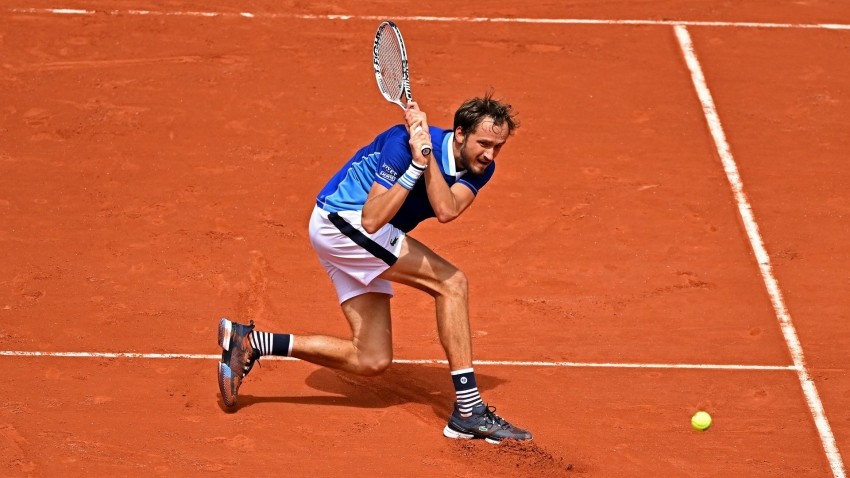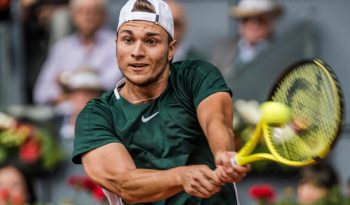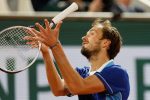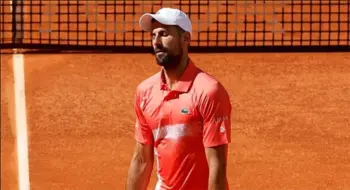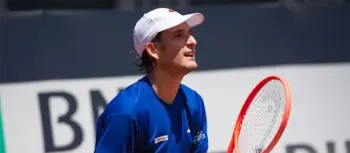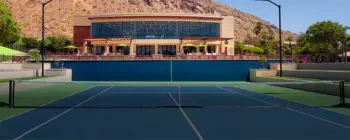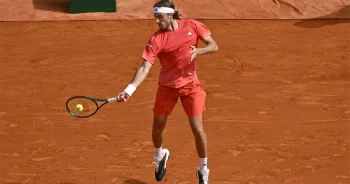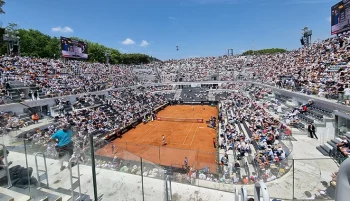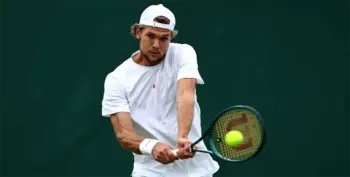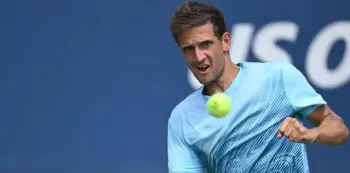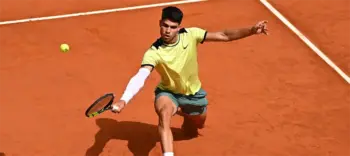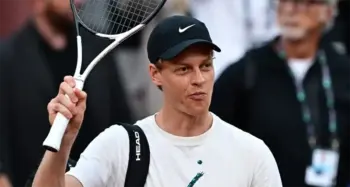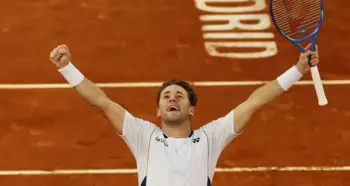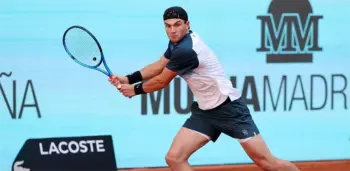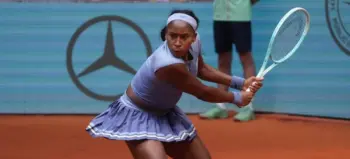Coach Evan is back with a match analysis, this time he deals with Medvedev vs Kecmanovic from the French Open third round.
Medvedev vs. Kecmanovic
by Evan Gaudreau
Sometimes I like to pick on coaches.
Ahhh!
Maybe that’s an understatement.
But sometimes, I like to validate coaches too.
Coaching at all levels can be challenging. We spend a lot of time on the court with the players and the parents.
Off the court too.
“What do you want to do this afternoon?” my wife asked as I sat at the desk making notes on a pad.
I had just gotten back from teaching and was making teaching notes with a red pen, thinking about the drills I used and the lessons I had that morning.
“Hello?”
“Huh?”
“I asked you what you wanted to do this afternoon?”
“I didn’t hear you. I was making some notes.”
“I can see that?”
I didn’t realize (all these years) that she was doing crap around the house all morning, so when I walked in the door and after I took a shower, we could be on the go.
She didn’t realize that my brain was going over the training I had that morning with the students and the process I go through thinking about the past training, the present, and what adjustments I need to make in the future.
As the day went on, I would drift in and out of the conversations we were having as I thought about the morning training,
Do a lot of coaches do this?
In some ways, I think they do; in others, I think they are more focused on ego and $$$.
Parents…
The phone calls from parents can be time-consuming. So are the conversations after the training.
“You were just on the phone for over an hour,” my wife said, frustrated.
“That’s part of the job with tournament parents.”
“You need to start charging a private lesson fee for those calls.”
“I’d feel weird doing that.”
“They’re taking time away from the family and us.”
She had a point.
So often, the tournament, players’ parents try to squeeze every penny and are focused on what they want and don’t give a hoot about what’s going on on the other side.
It’s Funny!
That sounds like a lot of people in life.
Give an inch, take a mile.
This brings us to this….one of my favorite players to watch before retiring.
David Nalbandian!
What he’s done with the kid is turn him into a solid top 30….almost.
This year, things are starting to click. The transition from adding a new coach generally takes 9-12 months, just for starters. Then things begin to move forward.
But what if you had a bad coach?
That would stink.
What if the problem was you and not the coach?
Attitudes
Where Tsitsipas is constantly pacing the court, looking like he’s in a hurry to get somewhere, presumably to the bathroom, Kecmanovic looks like the unhappiest dude on the court.
Both these attitudes are holding them back.
It’s not about the strokes.
It’s not as much about the training.
It’s who they are as people (and the environment they grew up in adds a lot to that).
Parents!
What if I told you that the reason your kid could only make it so far was because of you? Not the coaches (although some coaches can also be part of the problem).
Would you accept that?
No, right?
It would destroy the fantasy in your head and you’d feel worthless.
Put Simply!
The goal in life is mental growth!!
Not your kid turning into a professional athlete.
That’s just a by-product of the environment you created.
A little secret
Little secret.
Maybe the kids don’t want that.
I’m not telling you to hold back; I’m trying to re-wire your brain. The journey is the key to life success and what they learn about themselves.
I dabble in stupidity too, with my kids.
I lose focus on what’s important.
Maybe the training my kid does has nothing to do with being a twelve UTR and is more about the process of understanding herself and who she is to be successful in what SHE CHOOSES to do with her life after college.
But, for now, tennis is like a job.
A collaborative one, albeit.
In some ways, it’s something she has to do.
It’s a commitment.
But it’s not torture.
Everyone has limits and most kids will not be professional athletes.
Listen to Evan
(You can actually listen to my podcast with Evan here)
“Why are you listening to Evan?” said the doctor. “I went to Yale; you should be listening to me.”
“Yeah, He doesn’t know what he’s talking about,” said the lawyer. “He went to a rinky-dink college in Connecticut; I graduated from Harvard.”
How’s that working out for you!
If you have to tell people you are a success….Are you really a success?
Wake up.
Literally.
Rage Against the Machine.
“Although ya try to discredit, ya still never read it,
The needle I thread it, radically poetic,
Standin’ with the fury that they had in 66’
And like E-Double “I’m Mad”, Still knee deep in the systems shit….”
The song is a little heavy for the old-timers.
Now, “One more Unto the Breach, Dear Friends.”
Medvedev plays a game of possum
One big difference between a player like Medvedev and a player like Brooksby is how Medvedev uses his AD side “recycle” spot. It’s not just to recycle the point. He plays a game of possum. He hits the ball deep and “baits” the player to attack the line. And that’s what when he attacks.
A simple drill to work on this is “Dead Balls.” Have the player stand somewhere on the Ad side (depending on their level) and rip feeds into the Deuce side and have the player recover them with a hard angle crosscourt.
I’m an eye for an eye kind of guy. I like these drills because I will lay down the hurt with interest.
I should have been a hockey player.
Another big difference is how Medvedev gets out of trouble.
Quickly.
A timely ace.
A winner.
He seems to Houdini his way out of trouble, a lot.
On the backhand side he has the two-hander he can attack crosscourt and down the line.
More specifically, he trains for multiple outcomes.
When to attack, when to recycle.
It’s so much easier for players to have one out during point play, one recycle spot. It takes years to develop options.
And that’s if you have one coach in the process.
The more coaches you leave and then add….add to the problem of learning. There’s no cohesion. You are always starting from scratch. You may see success early but the wall will be hit and the parent will think it’s time to move on.
It’s funny but sad.
Push or attack?
Like life, one of something is one-dimensional. And what happens if that one thing is broken. Two of something is much better. You can absorb the loss. Three of something and now we’re talking.
Master one game plan and add to it.
Generally, at the club level, players either push or attack.
At the junior level, eight UTR and above, they start to add a little more….but if they spend too much time in the technical world or have too many mental reps on one strategy….when push comes to shove they will go back to the “beginning” for fear of losing.
Back to Nalbandian
Is he still Kecmanovic’s coach?
Or is the Coaching carousel continuing?
Funny note I made during the match. Medvedev used grunting as a tactic. In the first set at 3-2, he recycled the point while grunting during the first point. I’m not a big grunter, but I get the concept. Use the grunt to make your intentions known to your opponent. Medvedev is pointing out the fact with his grunt that he is recycling the point and trying to get it in his opponent’s head.
Another cool thing Medvedev (and Djokovic) do is flip-flop their attacks. They don’t always attack when the opponent redirects the ball while recycling the point. And it’s not random.
The first stage of learning (after you’re done with technique and accept your limitations) is to practice certain patterns when you are down and specific patterns when you are up. It makes sense to work on defensive patterns when you are down, which is fine, and aggressive patterns when you are up…
…but it’s also ok to flip-flop that idea too. Try serving and volleying at 15-30….once you succeed with that….it becomes the precursor to serving and volleying at 30-40….
Point training is a whole another beast. If you wait too long, you will have built up too many “one-dimensional” thoughts in your head that you can’t break out of.
Coaching can be a thankless job!
Side note: If Nalbandian is out as Kecmanovic’s coach, he should be snatched up ASAP.
